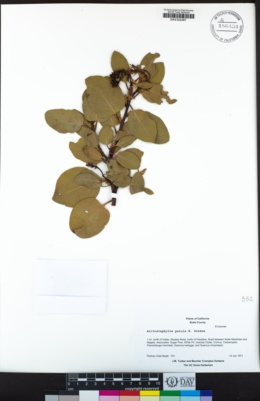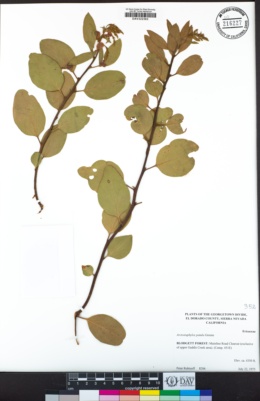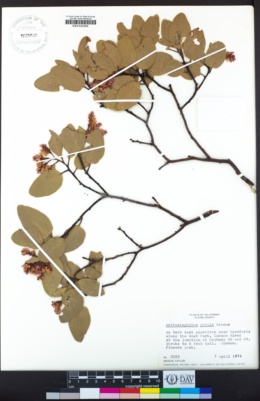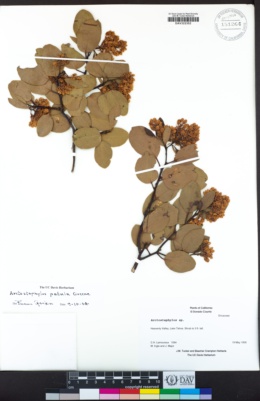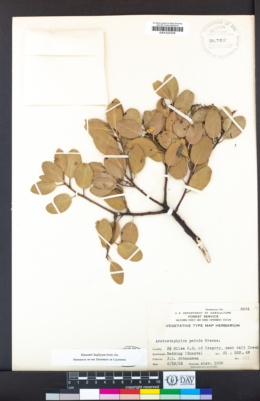Arctostaphylos patula
|
|
|
|
Family: Ericaceae
Green-Leaf Manzanita, more...greenleaf manzanita
[Arctostaphylos acutifolia Eastw., moreArctostaphylos parryana var. pinetorum (Rollins) Wies. & Schreib., Arctostaphylos patula subsp. platyphylla (A. Gray) P.V. Wells, Arctostaphylos patula var. coalescens W. Knight, Arctostaphylos pungens var. platyphylla A. Gray] |
Shrubs, erect or mound-forming, 1-3 m; burl usually absent, sometimes flat, obscure; twigs usually densely short-hairy with golden glands on tips of hairs, rarely short white-hairy and eglandular. Leaves: petiole 7-15 mm; blade bright green (lightly gray-green if short-hairy), shiny, widely ovate to orbiculate, 2.5-6 × 1.5-4 cm, base rounded, truncate, or slightly lobed, (not clasping), margins entire, plane, surfaces smooth, glabrous or, rarely, short-hairy. Inflorescences panicles, 2-8-branched; immature inflorescence pendent, branches spreading, axis 1.5-3 cm, 1+ mm diam., hairy with golden glands on tips of hairs or short-hairy and eglandular; bracts appressed with incurved tips, scalelike, deltate, 4-6 mm, apex acuminate, surfaces usually densely tomentose with golden glands on tips of hairs, rarely short white-hairy and eglandular. Pedicels 2-7 mm, glabrous or white-hairy. Flowers: corolla mostly pink, conic to urceolate; ovary glabrous or white-hairy. Fruits depressed-globose, sometimes subglobose, 7-10 mm diam., glabrous. Stones distinct. 2n = 26. Flowering late spring-early summer. Mountain chaparral and forests; 400-3000 m; Ariz., Calif., Colo., Mont., Nev., Oreg., Utah, Wash.; Mexico (Baja California). Arctostaphylos patula is abundant and widespread in western North America as a dominant in montane chaparral, pine forest gaps, and high-elevation arid-steppe and canyon-land environments. Populations throughout western North America are characterized by twigs and inflorescence parts covered with relatively short hairs tipped with golden glands. In the central to northern Sierra Nevada, mixed with the widespread form are individuals that are eglandular and have a cover of relatively short, whitish hairs on the stems and inflorescences. Similarly, throughout most of its range, A. patula is nonsprouting after fire, and in areas characterized by winter snow cover it layers and creates broad, low mounds. In much of California, it typically sprouts after fires from obscure and flattened burls, forming circles of erect sprouts.
Common Name: greenleaf manzanita Duration: Perennial Nativity: Native Lifeform: Shrub General: Evergreen erect shrub, 1-2 m (3-7 ft) tall, spreading clonally; branches ascending, stout, crooked, rooting where in contact with the soil surface; twigs finely hairy with stalked or sessile glands and often with a few long-spreading hairs. Bark smooth, thin, cinnamon to reddish brown, tardily exfoliating. Leaves: Alternate, simple, typically ovate to subrotund, sometimes broadly or more narrowly elliptic, 2.5-4 cm long, 1.5-4 cm wide, bright green, finely pubescent with glandular and non-glandular hairs to nearly glabrous with age, margins entire, base rounded, apex blunt and occasionally with a short mucronate tip; petiole 6-10 mm long, pubescent like the twigs. Flowers: Inflorescence a condensed panicle, the axis glandular; pedicels 2-7 mm long, glabrous; bracts lanceolate to awl- shaped, 1-4 mm, firm, tan or tinged with pink; sepals broadly ovate to orbicular and rounded at tip, 1.5-2 mm long, glabrous; corolla urn-shaped, 5-8 mm long, pink to white. Fruits: Berry-like drupe, flattened-globose, 8-11 mm in diameter, off-white to yellowish brown, glabrous. Ecology: Found in coniferous forests from 5,000-10,000 ft (1524-3048 m), flowers March-June. Distribution: Coconino and Navajo counties; western U.S. Notes: Greenleaf manzanita is highly drought tolerant. It has adapted two strategies to survive fire: seed banking and sprouting from a belowground woody tuber. Seeds require scarification from fire to break dormancy, followed by cold stratification. The species has the ability to severely deplete soil moisture, which leads to mortality of conifer seedlings growing in its vicinity. It is poor browse for most species, but the berries are eaten by many bird species, as well as rodents, bears, and coyotes, which all act as seed dispersers. Greenleaf manzanita is used for erosion control and as an ornamental. Ethnobotany: Berries are edible when picked young, before they become mealy. Dried leaves can be mixed with other herbs and used as tobacco. The dense wood makes it useful for carving pipes. Editor: Springer et al. 2011 |

























